|
|
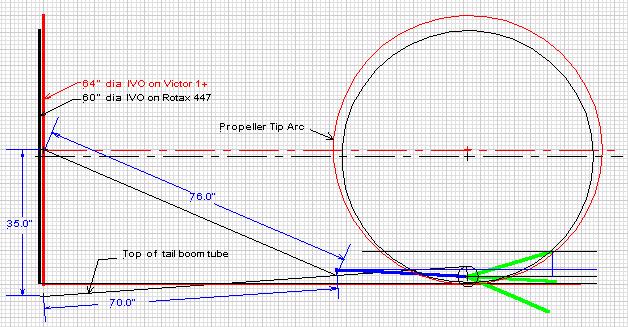
This subject came up on the Kolb List and so I measured the distance from the center of the propeller to the boom tube just below the leading tip of the horizontal stabilizer. Also, I placed a straight edge on the propeller hub and slid it down to the fuselage tube to locate and measure the straight-line distance for the center of the propeller in the rotational plane to the tube. And finally, I measured the distance from the rotation plane to the leading point on the horizontal stabilizer. These data were used to make a CAD scale drawing that included the top of the tail boom tube, the horizontal stabilizer and elevator. I included the Rotax 447 too, to see the difference would be. The Rotax thrust line center is 1.72 inches below that of the Victor 1+. Also the Victor 1+ is off set 3.89 inches to the left. |
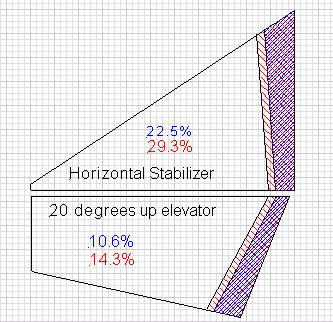 Graphically, the propeller arcs could be projected onto the horizontal stabilizer and elevator. By using the CAD Inquire feature, the scaled areas could be found to determine the percent areas that would be swept. The 64-inch diameter propeller sweeps a little wider path as shown by the red hatching.
Graphically, the propeller arcs could be projected onto the horizontal stabilizer and elevator. By using the CAD Inquire feature, the scaled areas could be found to determine the percent areas that would be swept. The 64-inch diameter propeller sweeps a little wider path as shown by the red hatching.
With the elevator in its maximum up position, the projected elevator propeller wash area is quite small. To come up with these drawings I found where the propeller arc would cut the front and trailing edges and I drew a straight line between these points. |
 With the elevator in its neutral position, the elevator propeller wash area becomes very small.
With the elevator in its neutral position, the elevator propeller wash area becomes very small.
I believe these percentages are a little larger that what really happens. This is because the measurements were taken under static conditions. If the engine was running, the thrust would tend crush the forward Lord mounts and to lighten the rear mount load. Also the propeller diameter was used to compute swept area, but it is well known that air leaving a propeller acts as a free jet and the jet cross sectional diameter is less than propeller diameter. All of the above assumes the propeller is mounted with no offset and that the air moves back toward the tail without any rotation. But with the Victor 1+ and to center the ball, the propeller is offset 3.89 inches to the left. Under power the engine will twist in the mounts so that the thrust line moves further to the left side. |
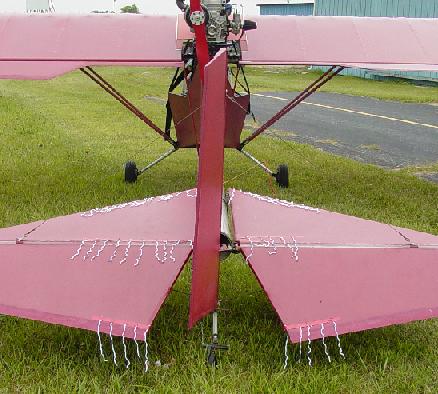 To check out calculation validity, I placed tufts on the horizontal tail surfaces. More tufts were placed on the left side to pick up thrust line offset.
To check out calculation validity, I placed tufts on the horizontal tail surfaces. More tufts were placed on the left side to pick up thrust line offset.
The FireFly was headed into the wind, and the tail was tied down. |
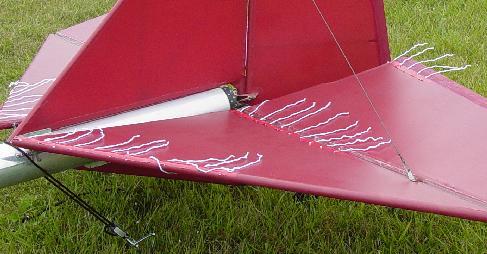 This is the left side with the engine turning 2,000 rpm and the elevator 20 degrees up. One can see that air is spilling into the slot between the tail boom tube and the stabilizer. It would be good to figure out a way to close this gap. And it is quite apparent that propeller airflow is touching the back inner edge of the elevator. Also at the hinge line some of the inner tufts bleed off into the gap between the elevator and rudder. But the next four head straight back indicating propeller flow. Then they start to waffle out indicating entrained airflow.
This is the left side with the engine turning 2,000 rpm and the elevator 20 degrees up. One can see that air is spilling into the slot between the tail boom tube and the stabilizer. It would be good to figure out a way to close this gap. And it is quite apparent that propeller airflow is touching the back inner edge of the elevator. Also at the hinge line some of the inner tufts bleed off into the gap between the elevator and rudder. But the next four head straight back indicating propeller flow. Then they start to waffle out indicating entrained airflow.
|
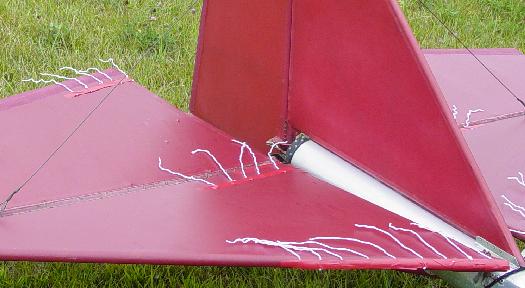 This is the right side, and the view is pretty much the same.
This is the right side, and the view is pretty much the same.
Next I increased engine speed to 3,000 rpm. I am remiss in that I did not take additional photos. The result was the same except that the definition line between direct propeller wash airflow and entrained airflow was much more distinct. Tufting is great for visualizing airflow across the surfaces, but it is not the easiest thing to do. If I had not wanted to take some photos, I would have used a ten-foot fishing pole with a foam bobber attached to the out end. |
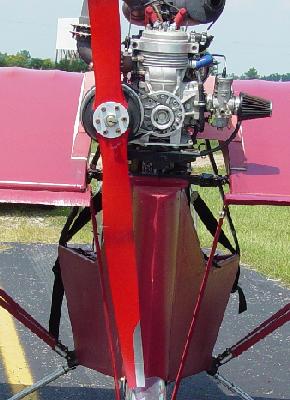 Because the previous calculations indicated that lowering the thrust line would improve propeller wash over the horizontal tail surfaces, I rotated the belt reducer another 45 degrees to the left. The propeller tip clears the tail boom tube by a little over one-half an inch. This places the thrust line 2.17 inches below and 5.50 inches to the left for that of the Rotax 447.
Because the previous calculations indicated that lowering the thrust line would improve propeller wash over the horizontal tail surfaces, I rotated the belt reducer another 45 degrees to the left. The propeller tip clears the tail boom tube by a little over one-half an inch. This places the thrust line 2.17 inches below and 5.50 inches to the left for that of the Rotax 447.
The propeller wash swept areas improved as follows:
Horizontal Stabilizer - 29.3 to 60.0% |
|
Significant Ground Handling & Take Off Improvement This change in propeller position has made a large difference in taxiing the FireFly through tall grass. While holding the stick back against the stop, one can apply much more throttle without lifting the tail. This change lets me land on the runway and taxi through the grass to the taxiway leading to my hangar. In the past I have put the FireFly on it's nose twice while trying to do this. Also, I can be more aggressive with the throttle on takeoff with out fear of blowing the FireFly over onto it's nose. Stick feedback and elevator down force is stronger. On takeoff I can hold the elevator in a more neutral position and let the tail come up rather than the FireFly struggling off in the three point stance. The FireFly accelerates faster and leaves the ground in a shorter distance than before. |
|
Stall Characteristics Due To Offset Thrust Center The following exert from my flight log describes what I discovered: July 16, 2007 - Flight 656 ...... Flew to check out the effect of horizontal stabilizer VG’s and gap seal on elevator authority and flaperon position and stall. Flew early in the morning so there were no thermals. Started out at 2,000 feet agl. No problems lifting the nose at 40, 45, & 50 mphi with flaperons fully extended. Maximum elevator deflection to raise the nose was slightly over ten degrees. Next I tried stalls at different throttle settings with no flaperons deployed. At 5,000 rpm with the stick back against the stop, 20 degrees of elevator deflection, the FireFly continued to forge ahead with no loss of altitude. At 4,500 rpm produced the same results, except FireFly was nervous on the right wing. 4,000 rpm produced a nice clean breaking stall with plenty of buffeting to let you know it was coming. The FireFly rolled to the right. This makes sense as the belt reducer is rotated to the left so the left wing gets more help from the propeller. |